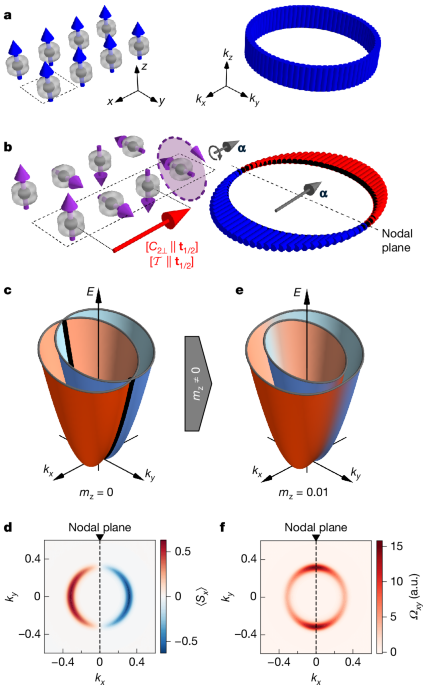
"Antiferromagnetic states with a spin-split electronic structure give rise to spintronic, magnonic and electronic phenomena despite (near-)zero net magnetization1,2,3,4,5,6,7. The simplest odd-parity spin splitting- p wave-was originally proposed to emerge from a collective instability in interacting electron systems8,9,10,11,12. Recent theory has identified a distinct route to realize p-wave spin-split electronic bands without strong correlations13,14, termed p-wave magnetism. Here we demonstrate an experimental realization of a metallic p-wave magnet."
"This texture breaks space-inversion symmetry but approximately preserves time-reversal symmetry up to a half-unit-cell translation-thereby fulfilling the symmetry conditions for p-wave magnetism. Consistent with theoretical predictions, our p-wave magnet shows a characteristic anisotropy in the electronic conductivity13,14,15. Relativistic spin-orbit coupling and a tiny spontaneous net magnetization further break time-reversal symmetry, resulting in a giant anomalous Hall effect (Hall conductivity >600 S cm −1, Hall angle >3%), for an antiferromagnet."
An experimental realization of a metallic p-wave magnet is reported. Delocalized conduction electrons develop an odd-parity spin splitting through coupling to a coplanar antiferromagnetic spin helix of localized moments whose magnetic period is an even multiple of the chemical unit cell, as revealed by X-ray scattering. The spin texture breaks space-inversion symmetry while approximately preserving time-reversal symmetry up to a half-unit-cell translation, fulfilling symmetry conditions for p-wave magnetism. The material exhibits characteristic anisotropic electronic conductivity and, when relativistic spin-orbit coupling and a small spontaneous net magnetization break time-reversal symmetry, a giant anomalous Hall effect (Hall conductivity >600 S cm−1, Hall angle >3%).
Read at Nature
Unable to calculate read time
Collection
[
|
...
]